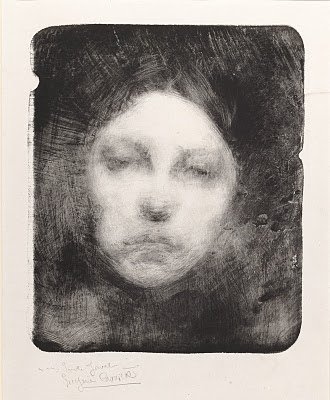
Eugène CARRIÈRE (1849 - 1906)
Buste de jeune fille, 1890
Buste de jeune fille, 1890
lithograph, 31 ´ 26 cm (image)
51 ´ 33.8 cm (sheet)
inscribed: in pencil Eugène Carrière and Mme. Emile Javal
on reverse: No.12 Buste de jeune fille Lithographie tiree a une cire
P.526
PROVENANCE: Hamilton Galleries, from whom purchased by Gallery, May 1966.
REFERENCES: L.Delteil, Le Peintre-Graveur Illustré (XIX - XX Siècles), 1913, vol.8, no.12.
Carrière was born at Gournay, Seine-et-Oise (now Seine-Saint-Denis) just east of Paris. His father (an insurance salesman) struggled to support his family, and, at the age of two, the family moved to Strasbourg. Carrière's early training was for a career in commercial lithography, but, after seeing works by Rubens in the Louvre, he decided that he would become an artist.
He struggled in his new career, resorting to commercial work in both Paris and London and at the Sèvres porcelain factory (1880-84), where he met Auguste Rodin (1840 - 1917). However, by the late 1880s he had achieved recognition for his work (being made Chevalier de la Légion d'Honneur).
His renewed interest in printmaking as an art medium, came about through the encouragement of his friends, and, from 1890 onwards he made a series of lithographs, many of which were used as frontispieces or published for print collectors.
JMcG

No comments:
Post a Comment